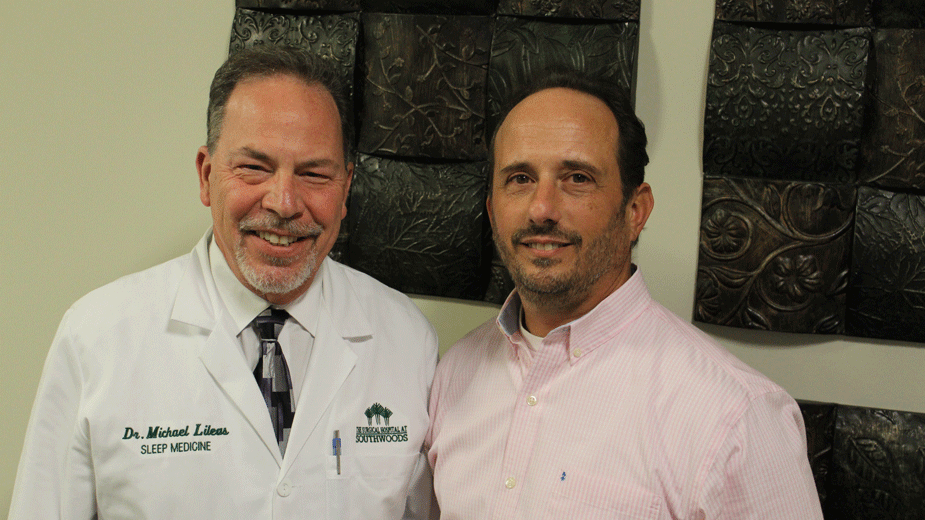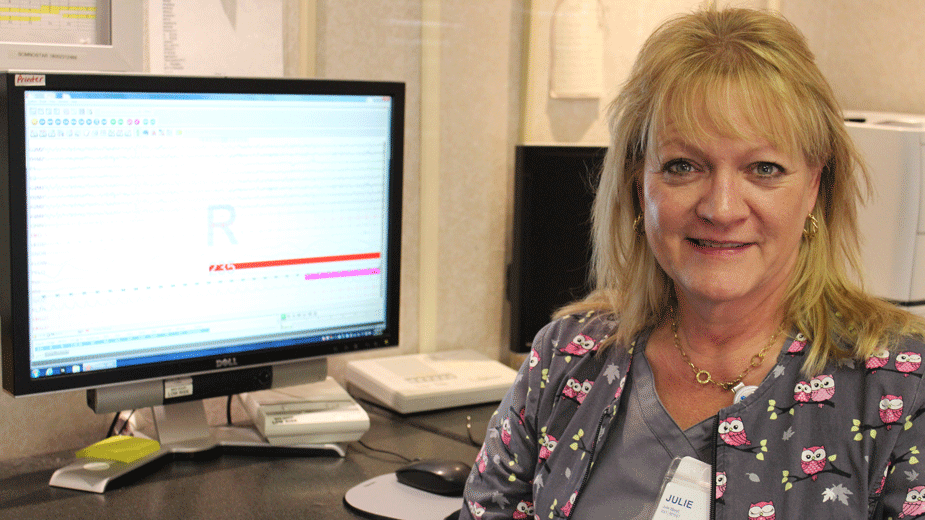Try to Sleep. You’re Being Tested
YOUNGSTOWN, Ohio – Walk past the lobby and small kitchenette, through the winding halls lined with occasional pieces of medical equipment, and you’ll find a few bedrooms.
Each has the usual amenities: a queen-sized bed, a TV, a recliner, even a nightstand. But a few things stand out, most notably the infrared camera and a metal stand with dozens of wires hanging from it.
“We try to set these up like hotel rooms,” says Julie Spayd, team coordinator at the St. Elizabeth Diagnostic Sleep Center in Boardman. “They have a queen or double bed. Some patients are used to recliners or have a hard time sleeping in a bed, so we have some rooms that have Craftmatic beds or adjustable recliners.”
Everything is designed to give clients at the sleep center a good night’s rest, even with wires and tubes and bands attached all over their bodies. With all of those hooked up, doctors can take a good look at exactly what your body is doing as you sleep.
Those little metal discs that rest on your head monitor electrical activity in the brain. Those on your legs help the doctors keep an eye on how much they move during the night. The plastic clip on your index finger measures the oxygen levels in your body and can show if – but more likely how often – you stop breathing.
“We have wires attached to the head for EEG. We’re looking at eye movement, chin movement, the EKG, a pulse oximeter and wires on the legs to measure those movements,” explains Maryann Winkle, who works in the sleep lab at Lifeline Partners in Liberty. “We’re looking at the sleep stages, their breathing, their snoring, their oxygen levels.”
 At Lifeline Partners, Maryann Winkle hooks patients up to sleep monitors.
At Lifeline Partners, Maryann Winkle hooks patients up to sleep monitors.
The information is relayed to the control room, where technicians watch the whole night through – or during the day, if the patient works nights. The data show up on computer screens in 30-second samples, providing a moment-by-moment look at sleep patterns.
“All those squiggly lines tell us what level of sleep someone’s in, whether they’re in REM sleep or a light Stage 1 sleep or in slow-wave sleep,” says Dr. Michael Lileas of Southwoods Sleep Center. “We can tell if their heart races during episodes or if their heartbeat is irregular.
A full night’s rest has four phases of sleep. For the first 10 or so minutes, in Stage 1, your eyes are closed and you fall into a light sleep. Here, breathing slows a bit as blood pressure and body temperature fall before you enter Stage 2, where you are a little less than half the sleep cycle.
In this second stage, the body prepares itself for deep sleep. On the control room monitors, this shows up as larger brain waves as your heart rate slows and other metabolic processes decrease. As this phase ends, you enter a deep, restorative sleep.
In stages 3 and 4, brain waves become larger and slower as the body begins to repair muscle and other tissue, readies the immune system and restores energy for the day ahead. These are the deepest stages of sleep.
What follows these steps is rapid eye movement, or REM, sleep, where you dream and brain activity is heightened. Muscles, save for the heart and lungs, are very limited in their functionality, which is where disorders such as apnea come into play as the body can’t rectify any blockage in the airway. Waking up during REM sleep causes a sense of paralysis and can leave you groggy for a few minutes as your brain works toward becoming fully awake.
Once you’re asleep, the process repeats, Stage 1 sleep replaced with REM sleep. Each cycle takes about an hour and a half and, as the night goes on, the dream stages get longer.
How all those lines of data appear on the screen can tell sleep labs technicians everything about your sleep patterns. If oxygen levels drop for sustained periods, apnea is the likely culprit because you stop breathing for up to a minute. If there’s sustained brain activity, it could be insomnia.
When patients first arrive, usually through a physician’s referral, it’s because they’ve had issues with their sleep that result from conditions such as apnea and insomnia. In some instances, doctors send patients when they see health issues but no obvious cause.
“What we see here is typically sleep hygiene. They’re not going to bed early enough,” Spayd says. “For an adult, they want you to get seven to eight hours of sleep. With our crazy lives, between stress and jobs and family, you’re lucky if people get five or six hours.”
That lack of sleep causes short-term problems such as fatigue, concentration problems and worsened memory. While those can cause problems in everyday activities, it’s the long-term effects that can be most worrying.
Those who sleep six or fewer hours a night are 30% more likely to be overweight. People with obstructive sleep apnea face increased risks of hypertension, stroke, cardiovascular disease and obesity. There is evidence, says Joe Petrolla, director at Southwoods Sleep Centers, that lack of sleep is connected to diseases such as diabetes and Alzheimer’s.
“The brain has a natural drain system,” he explains. “There are amino acids … in our brain that are necessary during the day, but can build up [without proper sleep] and cause plaque, which can lead to Alzheimer’s and dementia.”
 Dr. Michael Lileas and Joe Petrolla help run the Southwoods Sleep Center in Boardman.
Dr. Michael Lileas and Joe Petrolla help run the Southwoods Sleep Center in Boardman.
About 40 million people in the United States, he adds, have obstructive sleep apnea with a cardiovascular link.
“There are so many links between sleep disorders and poor sleep and things like heart disease, high blood pressure, diabetes, atrial fibrillation,” Southwoods’ Lileas says. “I get consults from cardiologists every day because they have someone with atrial fibrillation but have found no reason for it. Most of the time, it ends up being obstructive sleep apnea or central sleep apnea.”
Even if you aren’t diagnosed with one of the hundreds of sleep disorders – they range from periodic limb movement disorder to sleep paralysis – there are still steps everyone can take to sleep better, those in the sleep labs agree.
Near the top of the list: fewer electronics in the bedroom.
“Your brain can’t distinguish that light from sunlight. It causes the same chemical reaction that impacts melatonin,” Petrolla says. “That’s supposed to rise at night causing you to relax. But it doesn’t because it thinks [the lighted phone] is daylight. So now you’re up and your brain’s thinking.”
In many instances, stress plays a major role in preventing proper sleep, adds Spayd, as we try to do too much in 24 hours and, as a result, don’t sleep long enough.
“It’s the stress. The day-to-day things like taking care of the kids or elderly parents you have to check on or the demands of your job,” she says, adding stress is one of the biggest changes in sleep habits she’s seen in 25 years at a sleep lab. “And the less you get, it accumulates over time.”
Pictured: Julie Spayd, team leader at St. Elizabeth Diagnostic Sleep Center, monitors patients in the sleep lab throughout the night.
Copyright 2024 The Business Journal, Youngstown, Ohio.



